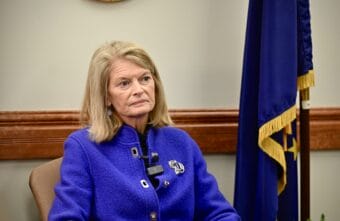
Forty-eight candidates will appear on the special primary ballot to fill out the remainder of the late Alaska Congressman Don Young’s term.
That’s the final number after some last-minute additions heading into the Friday cutoff and some subtractions by noon Monday, which was the deadline to withdraw and not have your name printed on the ballot.
It’s the most candidates ever in one election in Alaska. Alaska Public Media’s Casey Grove spoke with Washington correspondent Liz Ruskin about how political observers are making sense of the field.
Listen here:
The following transcript has been lightly edited for clarity.
Casey Grove: Liz, how do you even fathom this many candidates?
Liz Ruskin: I know! And let me remind our listeners. Voters can only pick one candidate in the primary. The top four vote-getters advance to the general. In the general, you’ll be able to rank them, 1 through 4. But it’s a pick-one primary.
Casey Grove: It definitely stood out that former Gov. Sarah Palin jumped into the race Friday. And then [former] President Trump endorsed her over the weekend. Doesn’t that kind of blot out the sun?
Liz Ruskin: It certainly does in the national consciousness. I expect she’ll pull in tons of money from Trump fans and Trump-aligned political action committees. But money doesn’t win elections. Votes do, and Palin has some negatives among conservative voters in Alaska. Some don’t like that she resigned from the governor’s office. Some don’t like that she’s been on the national stage more than she’s been weighing in on Alaska issues. But certainly she’s the most famous person in the race, and name recognition matters in a 48-way race.
Casey Grove: So, how do you sort all these candidates?
Liz Ruskin: Everybody I talked to today and over the weekend, everybody from the political world, is penciling out their lists of who they think is going to make it into the top four, who has name recognition, who can raise money.
Jeff Landfield, the political blogger, divided the list into three tiers, which is a useful way to think of it. His top tier has three candidates: Palin, Nick Begich III and Al Gross.
Nick has been in the race for months. Unlike most of the other Begiches, he’s a conservative Republican.
Al Gross is running as a nonpartisan, as he did when he challenged Sen. Dan Sullivan two years ago. That campaign gave Gross name recognition, and he has some leftover campaign cash.
Casey Grove: To be fair to everybody, we really don’t know how this is going to break down. They haven’t started campaigning yet. A lot of this is based on starting name recognition. Then the question is: Who is the fourth candidate who is going to make it into the general?
Liz Ruskin: Right. What we’re really going by is what name recognition people have going into the campaign, and that could change over the next few weeks.
Well, the next tier down, to go back to Jeff Landfield’s list, he’s got 10 people in it. There’s plenty of room to debate who belongs in tier 2. But among those names are people with a lot of smarts and experience who are well known in policy and political circles. You’ve got legislators, ex-legislators, respected Alaska Native leaders, local assembly members.
Casey Grove: And at least one well known garden columnist.
Liz Ruskin: Right, Jeff Lowenfels. And let me say — he doesn’t like being identified as just a garden columnist. He points out that he was an assistant attorney general on oil and gas issues, he worked in the private sector to advance Alaska’s gas line. I myself have referred to him as “garden columnist Jeff Lowenfels.” But when you’ve got 48 candidates, reporters — and the public — will likely abbreviate the labels of each one to sort through them all.
Casey Grove: What about Santa Claus?
Liz Ruskin: Santa Claus is a serious contender. I mean that. This is the Santa who is a council member of the city of North Pole. He’s a progressive. He says he shares a lot of Sen. Bernie Sanders’ positions. And his legal name is Santa Claus. People I talked to thought he had a chance to make it in the top four because he has name recognition. Progressives are going to like his politics. Some people are going to use it as a protest vote. In a 48-way race, a lot can happen.
Casey Grove: Everything we’ve talked about — that’s for the special election for the U.S. House seat, which will be a mail-in primary. The special general election will be in August, and the winner will hold the seat just until January. Liz, what about the regular election to fill the seat after that?
Liz Ruskin: The state will hold a primary election and a general election for that, too, but on the regular election dates, in August and November.
Casey Grove: Have all these candidates filed to run to fill the seat for the new term, too?
Liz Ruskin: No. In the regular election I counted 14 candidates in that race, but that deadline hasn’t fallen yet, so people can still file there.
Casey Grove: I have to ask: Is Sarah Palin one of the 14 who filed to run for the regular election?
Liz Ruskin: She is.


